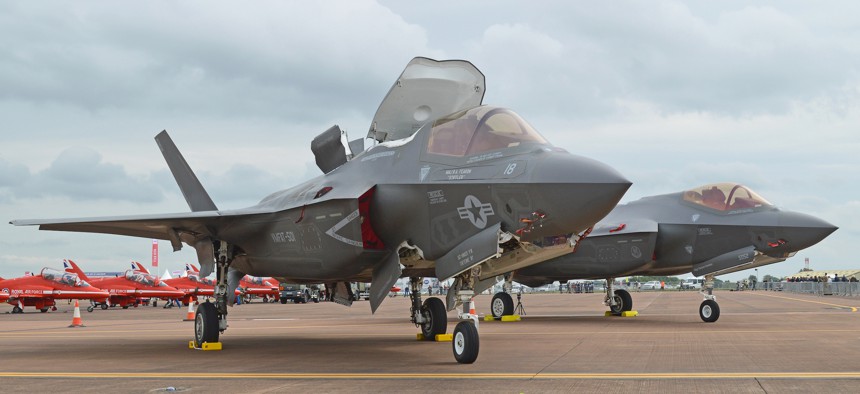
A Marine Corps F-35B sits in front of a US Air Force F-25A at the 2016 Royal International Air Tattoo, Fairford, UK. Alan Wilson
Don’t Expect the Military’s Next Fighter to Be Joint
While the Navy’s and Air Force’s next tactical jet might share some capabilities, a Navy official says, they won’t share an airframe.
After two decades of working side-by-side on the F-35 Joint Strike Fighter, the U.S. Navy and Air Force won’t be teaming to build a successor jet, a top Navy official said.
“I don’t necessarily foresee an exact sort of repeat of F-35 in a single solution set.” Angie Knappenberger, deputy director of air warfare for the deputy chief of naval operations for warfare systems, said Monday at the Navy League’s Sea Air Space conference in National Harbor, Maryland. “I do see an awful lot of capabilities and systems that we can take, share one service to another.”
When the F-35 was conceived in the 1990s, it was thought that three variants for Navy, Marine Corps, and Air Force might share about 70 percent of their parts, saving money. Almost 30 years later, the jets are only about 20 percent the same.
But the Navy and Air Force are on the same page about teaming drones with manned aircraft. In March, the Air Force touted the first flight of the XQ-58 Valkyrie, a jet-powered drone that could fly alongside manned warplanes. Knappenberger on Monday said the Navy is experimenting with similar technology.
“There are certain things and certain scenarios and certain mission sets perhaps that you might be able to get to an autonomous vehicle,” she said. “But we’re seeing a lot more ability to leverage some of that still autonomy, but still be in the loop with the manned system.”
The Navy is already teaming its Fire Scout drones with MH-60 Seahawk helicopters. Its planning to team the P-8 sub-hunting jet with an MQ-5C Triton. Boeing is building the new MQ-25, a drone that will fly off of aircraft carriers and refuel fighter jets mid-flight.
“Having a very similar mission set from the manned platform to the unmanned platform I think pays a lot of dividends in getting that unmanned platform very far ahead,” Knappenberger said.
Both the Navy and Air Force are studying what that next military fighter might look like.
“It truly is a different mission what we’re looking for in our next-generation air dominance versus what the Air Force is really looking for,” Knappenberger said.
Still, the planes might share some of the same capabilities.
“Because some of those systems are going to be very complimentary and we are looking forward to what the Air Force is going to be doing as I’m sure they’re going to be looking hard at what we’re going to be doing in that system development,” Knappenberger said.
In March 2016, the then-head of the F-35 program warned military leaders to think hard before embarking on another joint fighter jet program.
“I’m not saying they’re bad. I’m not saying they’re good. I’m just saying they’re hard,” now retired Air Force Lt. Gen. Christopher Bogdan said at the time. “You ought to think really hard about what you really need out of the sixth-generation fighter and how much overlap is there between what the Navy and the Air Force really need.”







